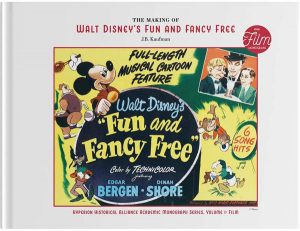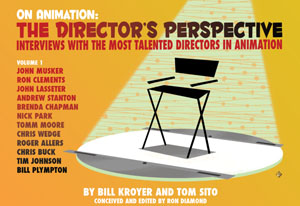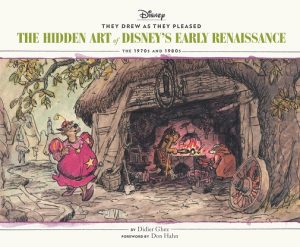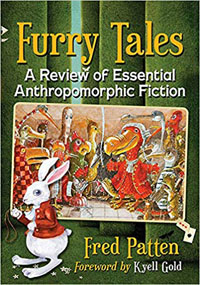The Making of Walt Disney’s Fun and Fancy Free By J.B Kaufman (Hyperion Historical Alliance Press).
 Well, I don’t know where to begin. But, spoiler alert, here’s the bottom line: Buy this book!
Well, I don’t know where to begin. But, spoiler alert, here’s the bottom line: Buy this book!
It goes without saying you should buy every book authored (or co-authored) by Disney historian J.B. Kaufman, but this one is special for several reasons. This time JB sets his sights on one of Disney’s “package films” of the 1940s – the first time any such feature (not counting Fantasia) has received such treatment. The Making of Fun and Fancy Free turns out to be more vital than Disney fans and enthusiasts may have thought.
The main reason is to learn the story behind Mickey and The Beanstalk – originally intended to be its own full length feature. Here is that story in lavish detail, explaining what was planned and what was deleted. Of course, the book also details the issues with adapting Sinclair Lewis’ Bongo, also planned to be a feature, and the decision to combine both into a “double feature” of a new type – something Roy Disney was initially wary of doing.
This feature became another opportunity to expand the studios effects animation and combination live action/animation technology; and another opportunity to boost the stardom of Mickey Donald and Goofy – as well as Jiminy Cricket. Kaufman’s book is the first of a series of historical monographs to be published by the Hyperion Historical Alliance, edited by Jim Hollifield. The Alliance has the support of the Disney Archives, and the visual material to support the text here is outstanding. Rare behind the scenes stills, model sheets, storyboards, etc. – A gold mine!
The Making of Walt Disney’s Fun and Fancy Free is a bit of a limited edition – so I urge you to buy it for yourself, right away for Christmas. You won’t regret it.
On Animation: The Director’s Perspective Vol 1 By Bill Kroyer and Tom Sito; Conceived and Edited by Ron Diamond (CRC Press)
 I am a sucker for animator interviews. Especially ones of artists I admire and respect. So here’s an early Christmas gift to me (and you). And its a Volume 1 – this is only the beginning.
I am a sucker for animator interviews. Especially ones of artists I admire and respect. So here’s an early Christmas gift to me (and you). And its a Volume 1 – this is only the beginning.
Producer Ron Diamond commissioned animation feature directors Bill Kroyer and Tom Sito to do 23 interviews with the biggest and best names working today. The common thread is that each interviewee has directed (or co-directed) an animated feature. Most have done more than one – and most have been behind some the biggest animated features ever made. The resulting Volume 1 publishes 12 of the Q&A sessions – and I’m happy to report this book a delightful and important read.
Among those submitting to the interviews are John Musker and Ron Clements, Nick Park, Andrew Stanton, Bill Plympton, Tomm Moore and John Lasseter. Though the interviews read in a breezy conversational tone, they are loaded with biographical information, and stories of behind the scenes production problems and successful personal breakthroughs.
This volume made its debut this weekend at the CTN Animation Expo in Burbank. I’ve devoured the first half of volume 1 last night. I’ve been told the second volume (featuring interviews with Brad Bird, Don Bluth, Henry Selick and Pete Docter, amongst others) will be out next week (on December 4th). I will post a more in-depth review of both volumes next month on my Animation Scoop blog.
For now, I’m going to have a ball reading the rest of these interviews over the holidays. From what I’ve read already, its a significant volume for everyone – fellow animators, enthusiasts and students. Highly Recommended!
They Drew as They Pleased Vol 5: The Hidden Art of Disneys Early Renaissance The 1970s and 1980s by Didier Ghez (Chronicle Books)
 The fifth volume of Didier Ghez incredible series is out – and if you don’t have the previous four – run out and get them now. That’s OK, we’ll wait.
The fifth volume of Didier Ghez incredible series is out – and if you don’t have the previous four – run out and get them now. That’s OK, we’ll wait.
The fifth edition focuses on the two biggest influences of Disney Studios post-Walt period: Mel Shaw and Ken Anderson. Half a book is devoted to each – and what a tremendous story (or stories) it tells. Though they left their biggest marks on The Aristocats, Robin Hood and The Rescuers both had deep Disney roots going back to the 1930s.
Both men are legends and their stories are delicious. Anderson was a Disney studio staple who’s hand has touched almost every important studio project ranging from The Goddess of Spring through Pete’s Dragon and onto Disney World and Disney TV cartoons (Gummi Bears), even The Disney Channel. Mel Shaw started at Schlesinger’s during the earliest Looney Tunes, went along with Harman and Ising to MGM, then off to Disney during (or right after) the production of Merbabies. The rest of his rollercoaster life takes us through Bambi, Uncle Remus and Mr. Toad. He then had a 25-year partnership with animator Bob Allen in a company designing Disney merchandise and developing Disney TV. Returning to the Disney studio as a full time employee in the 1970s, he became a star with his development art for The Rescuers, The Fox and The Hound and The Black Cauldron.
All of it is covered with rare pieces of development art, photographs and paintings. These Drew as They Pleased volumes are vital. Buy this today.
Furry Tales: A Review of Essential Anthropomorphic Fiction by Fred Patten (McFarland)
 Fred Patten was a close friend and business colleague of mine. He was also a valued regular contributor to this blog, Cartoon Research, since its inception. He passed away last year, on November 12th 2018, leaving one last contribution to the fantasy fandom he was so much a part of for over 60 years.
Fred Patten was a close friend and business colleague of mine. He was also a valued regular contributor to this blog, Cartoon Research, since its inception. He passed away last year, on November 12th 2018, leaving one last contribution to the fantasy fandom he was so much a part of for over 60 years.
Just published in September, Furry Tales is, as was all of Fred’s writing projects, a thoroughly researched work and an expertly written reference (or ref-fur-ence?). I myself am not a “furry”, but I am a big fan of Bugs Bunny, Mighty Mouse, and Kimba The White Lion. Furries take their love of such characters a bit farther than than I would – but it’s easy to see their connections to animation.
Fred was a major fan of comic art, animation and science fiction. He was a pioneer of anime fandom – writing intelligent articles about it way before anyone else. He was also a pioneer in chronicling Furry fandom – and his final book here is an intelligent look at great literature that falls into the furry domain. Its a survey of “Anthropomorphic Fiction” which, as defined in this book, includes Watership Down, Who Killed Roger Rabbit, The Last Unicorn, Animal Farm, Shinbone Alley, Charlottes Web, Bambi and Francis The Talking Mule, among others.
This is smart stuff. Not the kind of intelligence one associates with certain sectors of fandom. But that’s what Fred did. He shined a light on things others took for granted – or worse, others neglected as illiterate junk. Fred has the final word here. This book is a fitting tribute to one of our greatest pop-culture historians. I may not be a “furry”, you may not be a “furry”, but Patten’s last writings are worthy of our respect – and its a great read, too.
SHOUT OUTS and SHORT TAKES – Ramin Zahed’s 2019 “Art of” Books

My pal Ramin Zahed (editor of Animation Magazine) is the one-man dynamo behind this year’s best behind-the-scenes “art of” books. Here are three different films (one CG, one stop-mo and one hand drawn) with one thing in common: fantastic preliminary art, story sketches, character designs and color pallets. These books commemorate their productions and preserve this material for all to see, enjoy and learn from.
The Art of Klaus (Titan Books), like the film itself, is simply gorgeous. As a die-hard 2-D hand drawn fan, this is my favorite film of the year. This is a classic example of what I’ve coined ‘back to the future‘ – Director Sergio Pablos takes us back to the hand craft of drawn animation, but pushes the medium forward with progressive character designs, art direction and visual polish. Like last year’s Spiderverse, this is a film that looks like its preliminary art – capturing the artist’s hand frame by frame. And this book does the same, allowing us to stare at length at the artwork that went into it – and crediting those artists who made it happen. Here’s hoping this is the start of a new breed of animated feature – and this book captures the production process; an independent film (eventually backed by Netflix) that I believe will be remembered for years to come.
The Art of Missing Link (Insight Editions) dives headlong into the production process – with an emphasis on visual design – of this gorgeous animated feature. Laika continues to evolve the stop motion art with every film they make and the documentation here is vital for every student and fan of the medium. Once again Laika pushes the art form – the sheer amount of creative energy on display, from the early character sketches, to elaborate production paintings, to the sets, costumes and intricate replacement animation models – another minor movie miracle. This book is marvelous keepsake of a magnificent production.
The Art of The Addams Family (Titan Books) is a lot of fun. And how could it not be. Beginning with the classically eccentric characters – and character designs – by legendary cartoonist Charles Addams; director Conrad Vernon and his crew – which include co-director Greg Tiernan and character designer Craig Kellman – take us on the step-by-step journey from Addams warped mind to the big screen. This whole project is a hoot, with hilariously funny drawings, paintings, boards and color theories displayed on each page. To be honest, I found this book a lot more fun than the finished film! Lots of eye candy here – and much to enjoy. This and all of the above books are HIGHLY RECOMMENDED!


 Jerry Beck is a writer, animation producer, college professor and author of more than 15 books on animation history. He is a former studio exec with Nickelodeon Movies and Disney, and has written for The Hollywood Reporter and Variety. He has curated cartoons for DVD and blu-ray compilations and has lent his expertise to dozens of bonus documentaries and audio commentaries on such. Beck is currently on the faculty of Cal Arts in Valencia, UCLA in Westwood and Woodbury University in Burbank – teaching animation history. More about Jerry Beck [
Jerry Beck is a writer, animation producer, college professor and author of more than 15 books on animation history. He is a former studio exec with Nickelodeon Movies and Disney, and has written for The Hollywood Reporter and Variety. He has curated cartoons for DVD and blu-ray compilations and has lent his expertise to dozens of bonus documentaries and audio commentaries on such. Beck is currently on the faculty of Cal Arts in Valencia, UCLA in Westwood and Woodbury University in Burbank – teaching animation history. More about Jerry Beck [



































I have the FUN AND FANCY FREE book and “They Drew as They Pleased Vol. 5.” Both are awesome books!
What to you is “back to the future”, I choose to term “retronuevo” –
a logism stolen from the mighty Music historian/critic Nelson George.
I had no idea that Ken Anderson was actually involved in GUMMI BEARS. I wonder in what capacity.